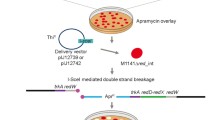Abstract
Genetic instability in Streptomyces species often involves large deletions sometimes accompanied by DNA amplification. Two such systems in Streptomyces lividans 66 involve the production of mutants sensitive to chloramphenicol and the production of mutants resistant to the galactose analogue 2-deoxygalactose, respectively. Overlapping cosmids were isolated that span the ca. 1 Mb region between the two amplifiable regions. The structure of the region was confirmed by restriction mapping using the rarely cutting enzymes AseI, BfrI and DraI and pulsed-field gel electrophoresis. The region contains a non-clonable gap flanked by inverted repeats; the structure is consistent with the presence of a physical gap, i.e. a linear chromosome.
Similar content being viewed by others
References
Altenbuchner J, Cullum J (1984) DNA amplification and an unstable arginine gene in Streptomyces lividans 66. Mol Gen Genet 195:134–138
Altenbuchner J, Cullum J (1985) Structure of an amplifiable DNA sequence in Streptomyces lividans 66. Mol Gen Genet 201:192–197
Betzler M, Dyson P, Schrempf H (1987) Relationship of an unstable argG gene to a 5.7 kb amplifiable DNA sequence in Streptomyces lividans 66. J Bacteriol 169:4804–4810
Birch A, Häusler A, Vögtli M, Krek W, Hutter R (1989) Extremely large chromosomal deletions are intimately involved in genetic instability and genomic rearrangements in Streptomyces glaucescens. Mol Gen Genet 217:447–458
Birch A, Häusler A, Hutter R (1990) Genome rearrangement and genetic instability in Streptomyces spp. J Bacteriol 172:4138–4142
Birnboim H, Doly J (1979) A rapid alkaline extraction procedure for screening recombinant plasmid DNA. Nucleic Acid Res 7:1513–1523
Chen CW, Tsai JF-Y, Chuang S-E (1987) Intraplasmid recombination in Streptomyces lividans 66. Mol Gen Genet 207 441–445
Chen CW, Yu T-W Lin Y-S, Kieser HM, Hopwood D (1993) The conjugative plasmid SLP2 of Streptomyces lividans is a 50 kb linear DNA molecule. Mol Microbiol 7:925–932
Chu G, Vollrath G, Davis RW (1986) Separation of large DNA molecules by contour-clamped homogeneous electric fields. Science 234:1582–1585
Cullum J, Flett F, Gravius B, Hranueli D, Miyashita K, Pigac J, Rauland U, Redenbach M (1991) Analysis of amplifications and deletions in Streptomyces species. In: Baumberg S, Krugel H, Noack D (eds) Genetics and products formation in Streptomyces. Plenum Press, New York, pp 265–272
Evans GA, Lewis K, Rothenberg BE (1989) High efficiency vectors for cosmid microcloning and genomic analysis. Gene 79:9–20
Feinberg AP, Vogelstein B (1983) A technique for radiolabelling DNA restriction endonuclease fragments to high specific activity. Anal Biochem 132:6–13
Flett F, Cullum J (1987) DNA deletions in spontaneous chloramphenicol-sensitive mutants of Streptomyces coelicolor A3(2) and Streptomyces lividans 66. Mol Gen Genet 207:499–502
Häusler A, Birch A, Krek W, Piret J, Hutter R (1989) Heterogeneous genomic amplification in Streptomyces glaucescens: Structure, location and junction sequence analysis. Mol Gen Genet 217:437–446
Hopwood DA, Kieser T, Wright HM, Bibb MJ (1983) Plasmids, recombination and chromosome mapping in Streptomyces lividans 66. J Gen Microbiol 129:2257–2269
Hopwood DA, Bibb MJ, Chater KF, Kieser T, Bruton CJ, Kieser HM, Lydiate DJ, Smith CJ, Ward JM, Schrempf H (1985) Genetic manipulation of Streptomyces: a laboratory manual. The John Innes Foundation, Norwich
Hornemann U, Otto DJ, Hoffmann GG, Bertinuson AC (1987) Spectinomycin resistance and associated DNA amplification in Streptomyces achromogenes subsp. rubradiris. J Bacteriol 169:2360–2366
Hutter R, Eckhardt T (1988) Genetic manipulation. In: Goodfellow M, Williams ST, Mordarski M (eds) Actinomycetes in biotechnology. Academic Press, London, pp 89–184
Ish-Horowitz D, Burke JF (1981) Rapid and efficient cosmid cloning. Nucleic Acids Res 9:2989–2998
Ishihara H, Nakano MM, Ogawara H (1985) Cloning of a gene from Streptomyces species complementing argG mutations. J Antibiotics 38:787–794
Kieser H, Kieser T, Hopwood DA (1992) A combined genetic and physical map of Streptomyces coelicolor A3(2) chromosome. J Bacteriol 174:5496–5507
Leblond P, Demuyter P, Simonet JM, Decaris B (1990) Genetic instability and hypervariability in Streptomyces ambofaciens: towards an understanding of a mechanism of genome plasticity. Mol Microbiol 4:707–714
Leblond P, Demuyter P, Simonet J-M, Decaris B (1991) Genetic instability and associated genome plasticity in Streptomyces ambofaciens: Pulsed-field gel electrophoresis evidence for large DNA alterations in a limited genomic region. J Bacteriol 173:4229–4233
Leblond P, Redenbach M, Cullum J (1993) Physical map of Streptomyces lividans 66 genome and comparison with the related strain Streptomyces coeliclor A3(2). J Bacteriol 175:3422–3429
Maniatis T, Fritsch EF, Sambrook J (1982) Molecular cloning, a laboratory manual. Cold Spring Harbor Laboratory, Cold Spring Harbor, New York
Piendl W, Köchel S, Flett F, Cullum J (1991) Deletion endpoints associated with an amplifiable DNA region in Streptomyces lividans. In: Genetics and products formation in Streptomyces. Baumberg S, Krugel H, Noack D (eds) Plenum Press, New York, pp 273–286
Smith GE, Summers MD (1980) The bidirectional transfer of DNA and RNA to nitrocellulose or diazobenzyloxymethyl paper. Anal Biochem 109:123–129
Yanisch-Perron C, Vieira J, Messing J (1985) Improved M13 phage cloning vectors and host strains: nucleotide sequences of the M13mpl8 and pUC19 vectors. Gene 26:101–106
Young M, Cullum J (1987) A plausible mechanism for large scale chromosomal DNA amplification in Streptomyces. FEBS Lett 212:10–14
Zhou X, Deng Z, Firmin JL, Hopwood DA, Kieser T (1988) Site-specific degradation of Streptomyces lividans DNA during electrophoresis in buffers contaminated with ferrous iron. Nucleic Acids Res 16:4341–4352
Author information
Authors and Affiliations
Additional information
Communicated by J. Schell
Rights and permissions
About this article
Cite this article
Redenbach, M., Flett, F., Piendl, W. et al. The Streptomyces lividans 66 chromosome contains a 1 MB deletogenic region flanked by two amplifiable regions. Molec. Gen. Genet. 241, 255–262 (1993). https://doi.org/10.1007/BF00284676
Received:
Accepted:
Issue Date:
DOI: https://doi.org/10.1007/BF00284676




